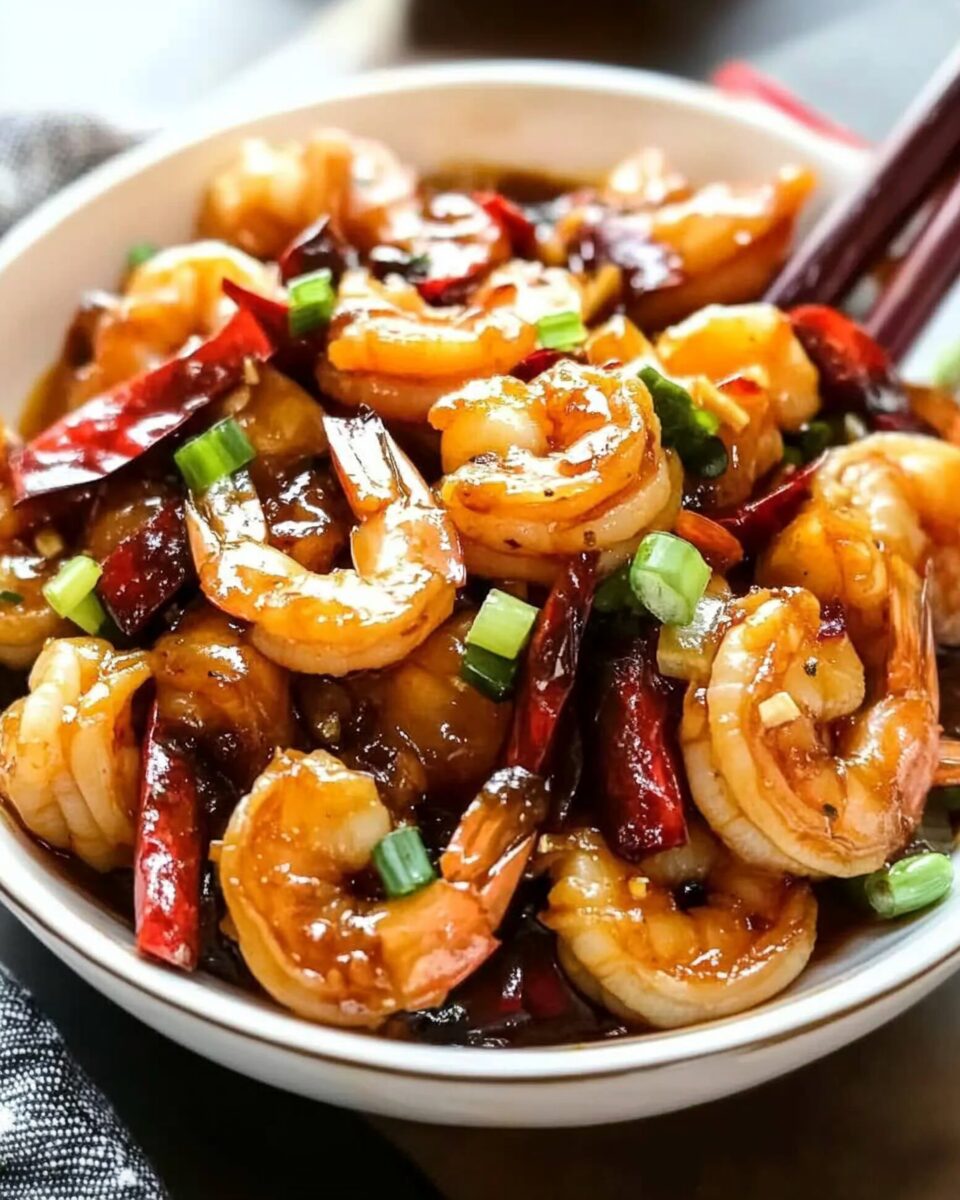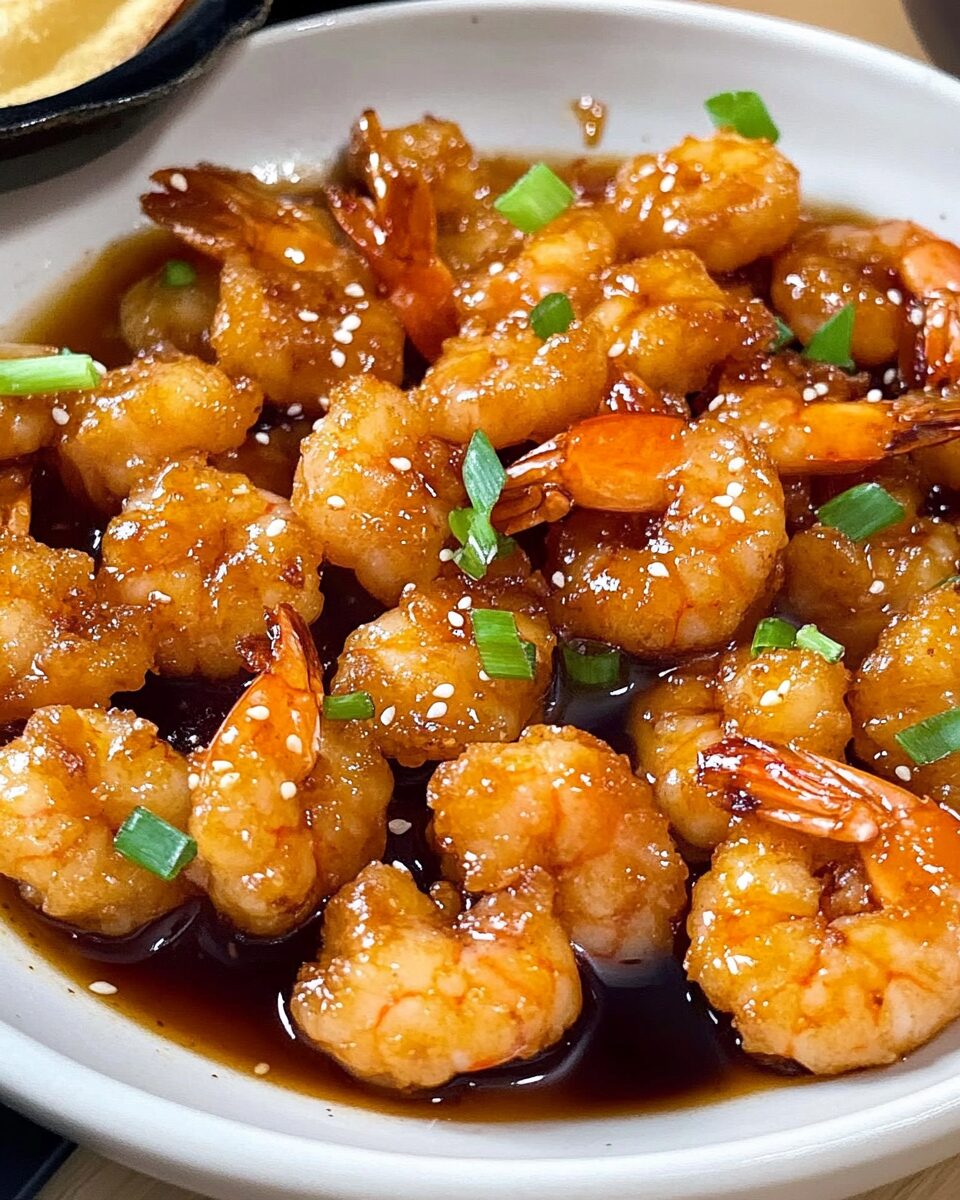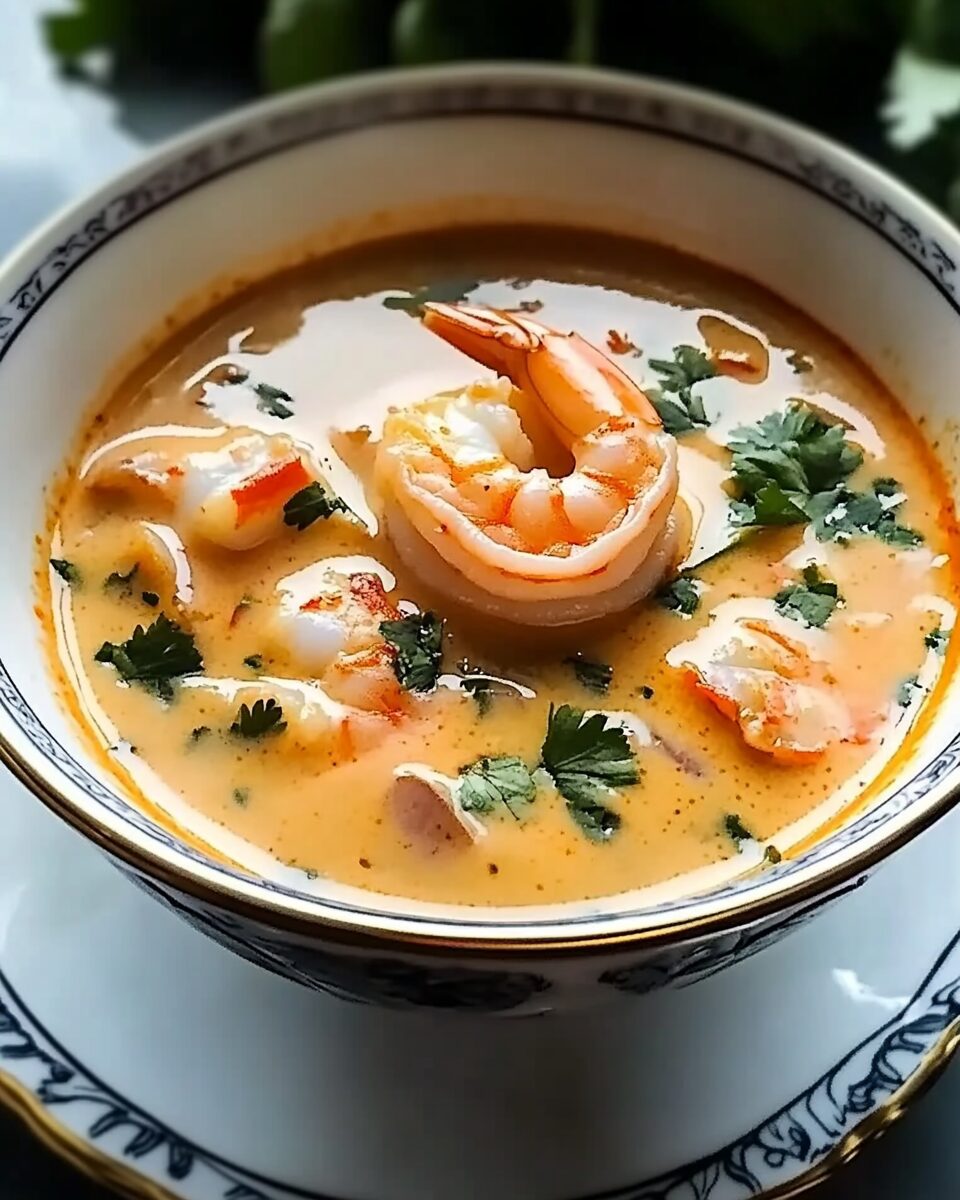Kung Pao Shrimp is a vibrant and flavorful Chinese stir-fry dish that combines succulent shrimp with a medley of vegetables, all tossed in a spicy and tangy sauce. This homemade version offers a healthier and tastier alternative to traditional takeout, delivering a satisfying meal that’s ready in just 30 minutes. The dish features a harmonious blend of textures and flavors, making it a delightful addition to your dinner repertoire.
Full Recipe:
Ingredients
For the Stir-Fry:
- 1 pound fresh raw shrimp, peeled and deveined
- 1 medium zucchini, diced
- 1 red bell pepper, chopped
- 1/2 cup canned bamboo shoots, drained
- 1/2 cup unsalted peanuts
- 2 green onions, chopped
- 4-6 dried red chilies, seeds removed
- 2 cloves garlic, minced
- 1 teaspoon fresh ginger, minced
- 2 tablespoons vegetable oil
For the Kung Pao Sauce:
- 2 tablespoons light soy sauce
- 1 teaspoon dark soy sauce
- 2 teaspoons rice vinegar
- 1 tablespoon water
- 1 1/2 tablespoons granulated sugar
- 1 teaspoon cornstarch
- 1 teaspoon sesame oil
Directions
-
Prepare the Ingredients: Pat dry the shrimp with paper towels. Dice the zucchini and chop the bell pepper. Drain the bamboo shoots. Remove seeds from the dried red chilies.
-
Mix the Sauce: In a small bowl, combine light soy sauce, dark soy sauce, rice vinegar, water, granulated sugar, cornstarch, and sesame oil. Stir until the sugar and cornstarch are dissolved.
-
Cook the Shrimp: Heat 1 tablespoon of vegetable oil in a wok or large skillet over high heat. Add the shrimp and stir-fry until they turn pink and are cooked through, about 2-3 minutes. Remove the shrimp from the wok and set aside.
-
Stir-Fry the Aromatics: In the same wok, add the remaining 1 tablespoon of vegetable oil. Add the minced garlic, ginger, and dried red chilies. Stir-fry for about 30 seconds until fragrant, being careful not to burn the garlic.
-
Add Vegetables: Add the diced zucchini and chopped bell pepper to the wok. Stir-fry for 2-3 minutes until they begin to soften but still retain some crunch.
-
Combine Ingredients: Return the cooked shrimp to the wok along with the bamboo shoots and peanuts. Pour the prepared Kung Pao sauce over the mixture. Stir well to ensure all ingredients are evenly coated with the sauce. Cook for an additional 1-2 minutes until the sauce thickens slightly.
-
Garnish and Serve: Remove from heat and stir in the chopped green onions. Serve the Kung Pao Shrimp hot over steamed rice or noodles.
Nutrients
Note: Nutritional values are approximate and may vary based on specific ingredients used.
- Calories: Approximately 280 kcal per serving
- Protein: 30g
- Carbohydrates: 18g
- Fat: 10g
- Saturated Fat: 1.5g
- Cholesterol: 220mg
- Sodium: 800mg
- Fiber: 3g
- Sugar: 7g
The Origins of Kung Pao Shrimp
While the exact origin of Kung Pao Shrimp can be traced back to the Sichuan province in southwestern China, its roots go deeper than just one region. Kung Pao, which translates to “palace guardian” in Chinese, was originally named after a Qing Dynasty official, Ding Baozhen, who was fond of the dish. The original version of Kung Pao was made with chicken, peanuts, and vegetables, though over time, variations with different proteins like shrimp, pork, and beef have become widespread. Kung Pao Shrimp is a contemporary take on the traditional Kung Pao Chicken, but it has gained popularity globally due to shrimp’s delicate texture and natural sweetness. The combination of shrimp with the rich, aromatic sauce makes it a mouthwatering dish that can be served as a main or a side.
Ingredients That Make Kung Pao Shrimp Stand Out
The unique flavors of Kung Pao Shrimp come from a few key ingredients. The base of the sauce is made with soy sauce, hoisin sauce, and rice vinegar. These ingredients provide a savory umami flavor with just the right amount of tanginess. What sets Kung Pao apart from other Asian stir-fries is the addition of Sichuan peppercorns, which add a distinctive numbing sensation to the dish, making each bite feel full of depth and complexity. Dried red chilies are also a fundamental element of the recipe, providing a pleasant heat. The dish is topped with roasted peanuts, which lend a crunchy contrast to the tender shrimp and the rich sauce.
Cooking Kung Pao Shrimp: Tips for the Best Flavor
To ensure the best Kung Pao Shrimp experience, there are a few tips you should follow during preparation. First, make sure your shrimp is fresh and properly cleaned. Shrimp should be peeled and deveined, and if you are using frozen shrimp, it’s important to thaw them completely before cooking to prevent any water from being released into the sauce. The stir-frying process is crucial for developing the perfect texture and flavor. The shrimp should be cooked quickly over high heat, ensuring they don’t become rubbery. Similarly, the dried chilies and Sichuan peppercorns should be toasted in the pan first to release their flavors before adding the sauce.
It’s also important to make the sauce separately and then combine it with the cooked shrimp, as this helps maintain the perfect consistency and balance of flavors. You can adjust the spice level by adding more or fewer dried chilies or Sichuan peppercorns, depending on your preference for heat.
Variations of Kung Pao Shrimp
While the traditional Kung Pao Shrimp recipe is beloved by many, it is a versatile dish that can be adjusted to suit different dietary preferences and tastes. Here are a few variations you can try to customize your Kung Pao Shrimp:
-
Vegetarian Kung Pao: If you prefer a vegetarian version, you can substitute the shrimp with tofu or tempeh for a similar texture. Use a plant-based sauce to ensure it is completely vegetarian-friendly.
-
Gluten-Free Kung Pao: For those following a gluten-free diet, simply use tamari or gluten-free soy sauce instead of regular soy sauce. Many hoisin sauces contain wheat, so be sure to use a gluten-free hoisin sauce as well.
-
More Heat: If you love spicy food, you can add more dried red chilies or even a fresh chili pepper to the sauce. Additionally, a dash of chili oil can enhance the heat and flavor.
-
Nuts and Veggies: Kung Pao Shrimp is traditionally topped with roasted peanuts, but you can substitute these with cashews or almonds for a different flavor. You can also add vegetables like bell peppers, onions, or carrots for extra texture and nutrition.
Serving Suggestions for Kung Pao Shrimp
Kung Pao Shrimp is often served with steamed rice, making it a satisfying and hearty meal. The rice soaks up the delicious sauce, which balances out the heat and flavor of the dish. For a lighter option, you can serve Kung Pao Shrimp over cauliflower rice for a low-carb alternative.
For an extra touch of flavor, garnish your Kung Pao Shrimp with fresh herbs such as cilantro or green onions. This addition not only enhances the visual appeal but also adds a burst of freshness to the dish.
Kung Pao Shrimp is also a great dish for meal prepping. You can make a large batch and store it in the fridge for up to three days. When reheating, be sure to warm it gently to avoid overcooking the shrimp.
Nutritional Benefits of Kung Pao Shrimp
Kung Pao Shrimp is not only a delicious dish but also a relatively healthy option, particularly if you make it at home. Shrimp is a great source of lean protein and is low in calories, making it an excellent choice for those looking to maintain a balanced diet. The dish contains a variety of antioxidants and nutrients, especially when combined with vegetables and nuts. Peanuts, for example, are rich in healthy fats and protein, while Sichuan peppercorns offer anti-inflammatory benefits. The use of rice vinegar and hoisin sauce also adds depth to the flavor without the need for excessive amounts of sugar or salt.
Conclusion: Why You Should Try Kung Pao Shrimp
Kung Pao Shrimp is a delicious and dynamic dish that brings bold flavors, crunchy textures, and satisfying protein together in one dish. Whether you’re cooking it for a weeknight dinner or preparing it for a special occasion, this dish is sure to impress. Its combination of shrimp, savory sauce, and roasted peanuts makes it a unique and flavorful choice for any home cook.








